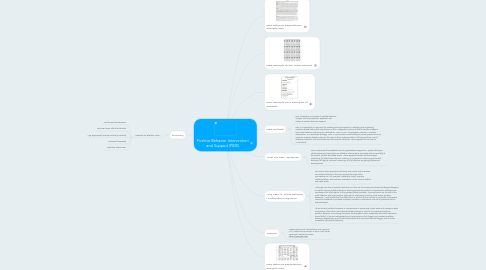Positive Behavior Intervention and Support (PBIS)
Door Sara Glascock

1. Summary
1.1. Rewards are Effective When:
1.1.1. Tied to specific behaviors
1.1.2. Delivered soon after the behavior
1.1.3. Age appropriate (actually valued by student)
1.1.4. Delivered frequently
1.1.5. Gradually faded away
2. PBIS Behavior Expectations, Example Two:
3. PBIS Example Three, Token Reward:
4. PBIS Example Four, Examples of Rewards:
5. PBIS Defined:
5.1. PBIS is based on principles of applied behavior analysis and the prevention approach and values of positive behavior support.
5.2. PBIS is a framework or approach for assisting school personnel in adopting and organizing evidence-based behavioral interventions into an integrated continuum that enhances academic and social behavior outcomes for all students. PBIS IS NOT a packaged curriculum, scripted intervention, or manualized strategy. PBIS IS a prevention-oriented way for school personnel to (a) organize evidence-based practices, (b) improve their implementation of those practices, and (c) maximize academic and social behavior outcomes for students. PBIS supports the success of ALLstudents.
6. What are PBIS “systems?”
6.1. PBIS emphasizes the establishment of organizational supports or systems that give school personnel capacity to use effective interventions accurately and successfully at the school, district, and state levels. These supports include (a) team-based leadership, (b) data-based decision-making, (c) continuous monitoring of student behavior, (d) regular universal screening, and (e) effective on-going professional development.
7. Why PBIS vs. Other Behavior Modification Programs?
7.1. The voices and perspectives of family and community members are involved directly in the PBIS process through active participation on, for example, leadership teams, practice implementation, and outcome evaluations at the school, district, and state levels.
7.2. Although PBIS has no specific restrictions on the use of consequence-based strategies designed to reduce serious problem behavior, teaching-oriented, positive, and preventive strategies are emphasized for all students, to the greatest extent possible. The emphasis is on the use of the most effective and most positive approach to addressing even the most severe problem behaviors. Most students will succeed when a positive school culture is promoted, informative corrective feedback is provided, academic success is maximized, and use of prosocial skills is acknowledged.
7.3. When student problem behavior is unresponsive to preventive school-wide and classroom-wide procedures, information about the student’s behavior is used to (a) understand why the problem behavior is occurring (function); (b) strengthen more acceptable alternative behaviors (social skills); (c) remove antecedents and consequences that trigger and maintain problem behavior, respectively; and (d) add antecedents and consequences that trigger and maintain acceptable alternative behaviors.
8. Sources:
8.1. Positive Behavioral Interventions and Supports. (n.d.). Retrieved December 5, 2015, from OSEP TEchnical Assistance Center: https://www.pbis.org/
9. PBIS Behavior Expectations, Example One:


